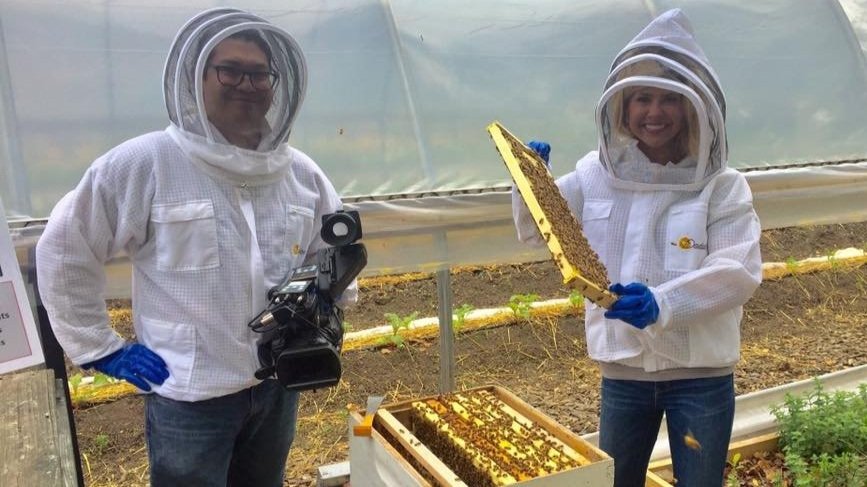Photojournalism Applied to Corporate Public Relations
Working as a photojournalist for a local TV news station is where I first cut my teeth learning how to visually tell a story. Sure, I had some background in the technical aspects of how to work a camera, but my strength coming out of college was actually geared more towards audio engineering. I left undergrad with a Bachelor’s of Music with an emphasis in music industry and a piano concentration (quite a mouthful!), so by the time I graduated I could play the piano pretty well and I could map the audio signal flow in a recording studio in my sleep.
Me shooting footage on the side of the highway (would not recommend)
It was during my last year and a half of college when I realized that if I wanted to find any kind of work after I graduated I needed to learn a broader set of skills. I thought that if I could edit video as well as audio then essentially my value would be doubled! I used my remaining elective credits to enroll in some basic photography and videography classes, bought a Canon DSLR with money from my job waiting tables, and started learning how to film and edit footage.
I was able to put together a basic demo reel from projects I worked on in college and a few freelance gigs I picked up during my last semester. With this reel as the centerpiece of my resume and cover letter combo I landed my first full time job as a production assistant at WTVR/CBS 6 in Richmond, VA. I was hired to operate the audio board during the early morning news broadcast and then work the cameras on the studio floor later in the day. After doing this for about a year a photojournalist position opened up so I expressed interest in applying and after an interview and in-field shadowing I was offered the position. This is when I actually start to learn how to shoot footage in an uncontrolled environment with the intention of creating a narrative.
Trial by Fire - that’s pretty much how I would describe the start of my photojournalist career. Sure, I knew how work a camera and edit footage in Final Cut Pro, but I had never conducted an interview or tried to shoot footage from multiple angles of uncontrolled action and then edit it all into a story in my car in less than two hours. I had no journalistic training but was handed a camera and a lavalier microphone and told “Get footage at this scene and we need sound from a witness.”
Shooting footage of a press conference with former Governor McAuliffe
I’ve been out of the news industry for almost five years now but I still use the skills in learned and developed as a photojournalist to craft PR stories and social content in the non-profit world. The video above is an example of a PR piece I put together using techniques I picked up from my news days.
Suited up to film a story about a local bee keeper
Controlled vs. Uncontrolled Environment
When you’re shooting footage at a scene as a photojournalist you normally have little to no control over what people do or say and have to be ready to capture compelling video at a moments notice. Something I had to adjust to when I started creating content for an organization is that I could now direct people and have them perform actions multiple times! In the Dominion Energy story I had them take the food bags from the restaurant owner and load them in the van several times and picked the smoothest take.
Producer vs. PR Team
In the news industry a producer will assign you stories and let you know if they want b-roll, a sound bite, or a fully edited story. You upload the footage into the system and they then put it in the show unless they have some changes to make. Making content for an organization is a completely different beast, often times I’ll be on location with someone else who is part of a PR or marketing team and they’ll often have their own vision for what the final product will look like but will lack the technical vocabulary and experience to express how to go about it in the moment. I’ve found myself shooting footage or feeding people lines in an interview that I know I’m not going to use just to make someone feel better about how the shoot is going. At first this annoyed me but experience has shown me that filming things to make the PR team happy in the moment ultimately makes things run much more smoothly down the line. Always have a plan for how you want the story to unfold and pitch that final vision, in the end you’ll still have the footage the PR team asked for and can throw it in if they won’t budge on it.
I was awarded a regional Emmy for my work covering tornado damage through Northern Neck, VA
I enjoyed my time working at WTVR/CBS 6, I made some great friends and learned a lot about how to visually tell a story. Ultimately the news industry wasn’t for me, the wild hours and often times heavy subject matter of the stories I had to work on started to wear on me. I decided to take the lessons I learned working for TV news and apply them to content creation, digital marketing, and public relations. I make an conscious effort to keep learning new skills and techniques, and I’ve even earned an MBA with a digital marketing focus but I still find myself going back to the basics of storytelling that I learned as a photojournalist at a local TV news station.




